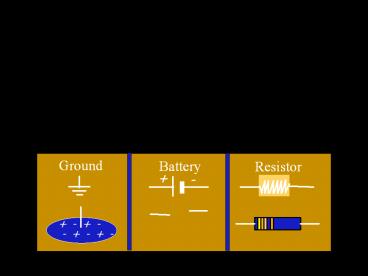Electrical Circuit Symbols - PowerPoint PPT Presentation
Title:
Electrical Circuit Symbols
Description:
Electrical Circuit Symbols – PowerPoint PPT presentation
Number of Views:2990
Avg rating:3.0/5.0
Title: Electrical Circuit Symbols
1
Electrical Circuit Symbols
Electrical circuits often contain one or more
resistors grouped together and attached to an
energy source, such as a battery.
The following symbols are often used
2
Resistances in Series
Resistors are said to be connected in series when
there is a single path for the current.
The current I is the same for each resistor R1,
R2 and R3.
The energy gained through E is lost through R1,
R2 and R3.
The same is true for voltages
For series connections
I I1 I2 I3 VT V1 V2 V3
3
Equivalent Resistance Series
The equivalent resistance Re of a number of
resistors connected in series is equal to the sum
of the individual resistances.
VT V1 V2 V3 (V IR)
ITRe I1R1 I2R2 I3R3
But . . . IT I1 I2 I3
Re R1 R2 R3
4
Example 1 Find the equivalent resistance Re.
What is the current I in the circuit?
Re R1 R2 R3
Re 3 W 2 W 1 W 6 W
Equivalent Re 6 W
The current is found from Ohms law V IRe
I 2 A
5
Sources of EMF in Series
The output direction from a source of emf is from
side
Thus, from a to b the potential increases by E
From b to a, the potential decreases by E.
Example Find DV for path AB and then for path
BA.
AB DV 9 V 3 V 6 V
BA DV 3 V - 9 V -6 V
6
Summary Single Loop Circuits
Resistance Rule Re SR
Voltage Rule SE SIR
7
Parallel Connections
Resistors are said to be connected in parallel
when there is more than one path for current.
For Parallel Resistors
V2 V4 V6 VT
I2 I4 I6 IT
For Series Resistors
I2 I4 I6 IT
V2 V4 V6 VT
8
Equivalent Resistance Parallel
VT V1 V2 V3
IT I1 I2 I3
Ohms law
The equivalent resistance for Parallel resistors
9
Example 3. Find the equivalent resistance Re for
the three resistors below.
Re 1.09 W
For parallel resistors, Re is less than the least
Ri.
10
Example 3 (Cont.) Assume a 12-V emf is connected
to the circuit as shown. What is the total
current leaving the source of emf?
VT 12 V Re 1.09 W
V1 V2 V3 12 V
IT I1 I2 I3
Ohms Law
Total current IT 11.0 A
11
Example 3 (Cont.) Show that the current leaving
the source IT is the sum of the currents through
the resistors R1, R2, and R3.
IT 11 A Re 1.09 W
V1 V2 V3 12 V
IT I1 I2 I3
6 A 3 A 2 A 11 A
Check !
12
Short Cut Two Parallel Resistors
The equivalent resistance Re for two parallel
resistors is the product divided by the sum.
Re 2 W
13
Series and Parallel Combinations
In complex circuits resistors are often connected
in both series and parallel.
In such cases, its best to use rules for series
and parallel resistances to reduce the circuit to
a simple circuit containing one source of emf and
one equivalent resistance.
14
Example 3. Find the equivalent resistance for
the circuit drawn below (assume VT 12 V).
Re 4 W 2 W
Re 6 W
15
Example 3 (Cont.) Find the total current IT.
Re 6 W
IT 2.00 A
16
Example 3 (Cont.) Find the currents and the
voltages across each resistor.
I4 IT 2 A
V4 (2 A)(4 W) 8 V
The remainder of the voltage (12 V 8 V 4 V)
drops across EACH of the parallel resistors.
This can also be found from V3,6 I3,6R3,6 (2
A)(2 W)
V3 V6 4 V
(Continued . . .)
17
Example 3 (Cont.) Find the currents and voltages
across each resistor.
V6 V3 4 V
V4 8 V
I3 1.33 A
I6 0.667 A
I4 2 A
Note that the junction rule is satisfied
IT I4 I3 I6
SI (enter) SI (leaving)
18
Kirchoffs Laws for DC Circuits
Kirchoffs first law The sum of the currents
entering a junction is equal to the sum of the
currents leaving that junction.
Junction Rule SI (enter) SI (leaving)
Kirchoffs second law The sum of the emfs
around any closed loop must equal the sum of the
IR drops around that same loop.
Voltage Rule SE SIR
19
Sign Conventions for Emfs
- When applying Kirchoffs laws you must assume a
consistent, positive tracing direction.
- When applying the voltage rule, emfs are
positive if normal output direction of the emf is
with the assumed tracing direction.
- If tracing from A to B, this emf is considered
positive.
- If tracing from B to A, this emf is considered
negative.
20
Summary Kirchoffs Laws
Kirchoffs first law The sum of the currents
entering a junction is equal to the sum of the
currents leaving that junction.
Junction Rule SI (enter) SI (leaving)
Kirchoffs second law The sum of the emfs
around any closed loop must equal the sum of the
IR drops around that same loop.
Voltage Rule SE SIR
21
Summary of Formulas
Rules for a simple, single loop circuit
containing a source of emf and resistors.
22
Summary (Cont.)
For resistors connected in series
For series connections
I I1 I2 I3 VT V1 V2 V3
Re R1 R2 R3
Re SR
23
Summary (Cont.)
Resistors connected in parallel
For parallel connections
V V1 V2 V3 IT I1 I2 I3
24
CONCLUSION Chapter 28ADirect Current Circuits































